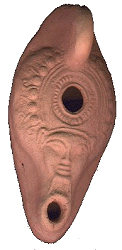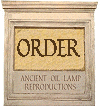
|
Reproduction Ancient Oil Lamps
Egypt
The replica ancient oil
lamps in this section represent clay lamp styles used in ancient
Egypt in the Greek Hellenistic to Roman and Roman Christian
period. Several of
these clay lamps are
molded directly from original ancient Egyptian oil lamps.
Sales will resume in 2024.

 |
ABYDOS
Circa 2nd to 4th Century AD
The globular body of
this
uniquely
Egyptian lamp features a stylized relief of a frog, the symbol of Heket,
who, in Egyptian religion, was associated with childbirth and the
renewal
of life. The use of the frog on lamps by Egyptian Christians is also
well
documented and probably also served as a symbol of renewal, in the
Resurrection. This was probably an extension of the appearance of frogs
connected with the rise and fall of the waters of the Nile. The find
location of this lamp is unfortuantely, unknown, but similar ones have
come from Abydos, Edfu, and Cairo.
Molded
directly from the original.
(3" by 2.5")
|

 |
AMARNA
Circa
2nd to 4th Century AD
This
style
also falls
into the "frog" lamp category. While many of these lamps had very
abstract
frogs, this one appears to be more of a floral pattern than anything. A
pleasing lamp, very Egyptian looking, and a good representation of the
original.
Molded
directly from the
original.
(3" by 2.75")
|

 |
SAQQARA
Circa
2nd to 4th Century AD
Again, a stylized
"frog"
lamp..
The
decoration
on this lamp is quite abstract, almost appearing like palms.
Molded
directly from an
original.
(2.75" by 2.25")
|

 |
HELIOPOLIS
Circa 2nd to 4th Century AD
Although included with
Egyptian lamps as it has a
general body shape like the frog lamps above, this style is also found
in Judea and many
of the Roman provinces.
(3" by 2.5")
|

 |
HATHOR
An "Egyptian" lamp of Hellenistic or
Roman period style featuring a face popularly called a Hathor lamp.
While exhibiting an "Egyptian" flavour, this style is likely an invention of
19th century artisans for the tourist trade. Examples have appeared in
collections since Victorian times, but archaeologically excavated
examples have yet to be published so far as I know. If you see one of
these on a popular internet auction site- assume with confidence it's
not actually ancient. This
example
was created from an example acquired from an Egyptian marketplace.
(about 3.5" by 1.75").
|
|






